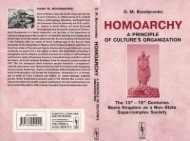L. Fituni, I. Abramova Resource Potential of Africa and Russia's ...
L. Fituni, I. Abramova Resource Potential of Africa and Russia's ...
L. Fituni, I. Abramova Resource Potential of Africa and Russia's ...
Create successful ePaper yourself
Turn your PDF publications into a flip-book with our unique Google optimized e-Paper software.
term economic development. The nation possesses the world's richest<br />
bauxite deposits. However, more than three-quarters <strong>of</strong> all bauxites<br />
have been obtained on the basis <strong>of</strong> the Guinean government's<br />
joint participation with foreign capital.<br />
In the first years after gaining independence geological work has<br />
been conducted in Guinea by foreigners alone. During the period <strong>of</strong><br />
Soviet-Guinean cooperation a Polytechnics Institute has been<br />
opened in the country <strong>and</strong> Guinean specialists have gained a wealth<br />
<strong>of</strong> experience in geological work. In 1971, the Guinean National<br />
Geological Organization decided to ensure the necessary conditions<br />
for organizing work to explore the country’s mineral resources. Soviet<br />
organizations were assisting Guineans in this field; inter alia,<br />
by setting up the Central Geological Laboratory.<br />
The country's first national mining enterprise was the Kindia<br />
mine with a capacity <strong>of</strong> 2.5 million tons <strong>of</strong> bauxites a year, built<br />
with Soviet assistance on a compensatory basis. All units <strong>of</strong> the<br />
complex (mine itself, railway stretching for 100 kilometers, loading<br />
<strong>and</strong> unloading installations in the port <strong>of</strong> Conakry, workers' communities,<br />
etc.) have been financed through Soviet credits.<br />
A considerable part <strong>of</strong> bauxites mined there was purchased by<br />
the USSR as a form <strong>of</strong> repaying the credits granted to Guinea, <strong>and</strong><br />
also under a trade agreement. As a result, Guinea's capacity to repay<br />
its debt <strong>and</strong> to buy commodities in the East were broadened considerably.<br />
This cooperation was to mutual advantage. The Soviet Union<br />
now had stable source for importing bauxites used in the production<br />
<strong>of</strong> aluminum <strong>and</strong> abrasives.<br />
The financial scheme was developed by the Soviet GKES specialists<br />
<strong>and</strong> customized to meet the requirements <strong>of</strong> the Guinean<br />
side. Curiously enough, as many other ex-Soviet know-hows, this<br />
very scheme is currently used by China in its business dealings with<br />
<strong>Africa</strong>n economic partners. Western analysts call it now “Angola<br />
model” <strong>and</strong> many believe it to be an innovative Chinese invention 53 .<br />
They call it “Angola model” because PRC used the scheme in order<br />
to finance the delivery <strong>of</strong> oil from that country. Since 2004 Angola<br />
received US$5 billion worth <strong>of</strong> Chinese loans for delivery <strong>of</strong> oil to<br />
China. The model was also used in a US$9 billion contract with the<br />
110







